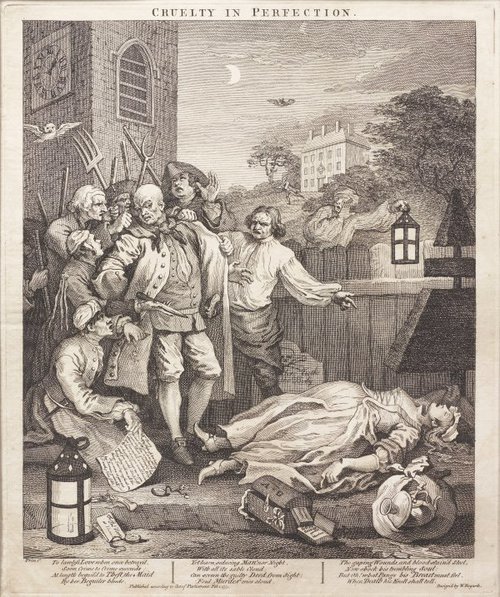William Hogarth
England
Born: London, England 10 Nov 1697
Died: London, England 1764
Biography
Hogarth was the first major British artist equally famous in his day as a painter, engraver and polemicist, who championed the cause of British artists over foreign influences. He was the son of a schoolmaster and Latin scholar, but served his apprenticeship as a silver engraver and by 1720 had set himself up as an engraver and printmaker. From an early stage he was producing elaborate satirical prints on topical affairs, such as his South sea scheme 1721, but by 1728 Hogarth had also emerged as an accomplished painter, having received instruction at Venderbank and Chéron’s academy and, seemingly, from the painter Sir James Thornhill (whose daughter he married in 1729).
In the 1730s Hogarth started painting his ‘modern moral subjects’, A harlot’s progress 1732 and A rake’s progress 1735, each a series of narrative paintings widely disseminated through the artist’s own engravings. These earned him huge popular success, so much so that cheap copies of Hogarth’s work appeared on the market, leading to the passing in 1735 of the Copyright Act (also known as Hogarth’s Act), which protected his prints from piracy.
The resulting financial security allowed Hogarth to paint, for no fee, two major wall paintings for St Bartholomew’s Hospital (thereby stealing a commission originally awarded to the Italian painter Jacopo Amigoni). In the late 1730s he took up portraiture, evolving a style which emulated, without closely imitating, French baroque prototypes, examples of which include the full-length portrait of Thomas Coram (Foundling Hospital, London) and his three quarter-length seated portrait of Bishop Hoadly (Tate Britain, London).
While he continued to produce moralising paintings (the Marriage a-la-mode series of 1743 being the most famous), Hogarth also devoted much effort to satirical prints such as Gin lane 1751 and Beer street 1751. He hoped that prints of this kind would help cure the social evils they depicted and to this end he also experimented with producing cheap woodcut versions, though the idea did not take off.
In 1753 he also published a treatise entitled The analysis of beauty offering an essentially pragmatic and anti-academic investigation into what makes a work of art pleasing to the eye. In this task he may have been helped by his friend Dr Benjamin Hoadly, MD, who he painted in the early 1740s. Hoadly, a fellow of the Royal College of Physicians, was also a playwright, who shared with Hogarth a sense of the satirical. Along with his brother John Hoadly he wrote a play in 1731 titled The contrast or a tragical comical rehearsal of two modern plays, which provoked controversy by satirising living authors and was subsequently withdrawn.
Hogarth received recognition at court in 1757 with his appointment as Serjeant Painter to the King. However, his final years were spend in failing health responding to attacks on his art and politics, which left him defensive and embittered. From the 1730s onwards he had railed consistently against the contemporary taste for dubious old master paintings. In his Time smoking a picture 1761, created in the final years of his life, the allegorical figure of time holds a scythe that pierces a canvas, making the point that time is not a beautifier of taste, but a destroyer.








